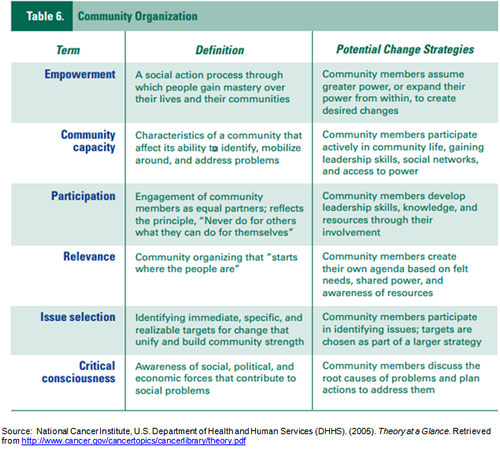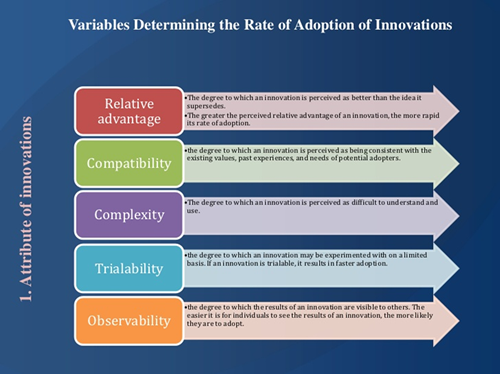Online Course
NRSG 780 - Health Promotion and Population Health
Module 9: Program Planning: Focus on Behavior Change
Community-Level Behavior Change
Community-level models provide frameworks for multi-dimensional approaches to health promotion. They augment educational efforts by incorporating strategies to change the social and physical environment to encourage behavior change. Community-level models are the key to public health approaches to preventing and controlling disease. They utilize an ecological approach to explore how social systems function and change and how community members and organizations can mobilize to support positive behavior change. Community-level models provide evidence-based strategies for a variety of settings including health care organizations, schools, worksites, community groups and government agencies.
.
Frameworks for Intervening on the Community-Level
- Community Organization/Participatory Models
- Diffusion of Innovation
- Relative advantage
- Compatibility
- Complexity
- Trialability
- Observability
- Innovators
- Early adopters
- Early majority adopters
- Late majority adopters
- Laggards
- Communication Theories
- Tailored messages at the individual level
- Targeted messages at the group level
- Social marketing at the community level
- Media advocacy at the policy level
- Mass media campaigns at the population level
These models help community groups to identify common problems, mobilize resources and develop and implement strategies to reach collective goals. The models generally involve community development, social planning and social action to increase the community’s capacity to solve problems. They utilize a variety of techniques to achieve change noted in the table below.

Advocacy is an important tool in community organization and effective program planning. Health policies, within organizations and on the local, state and national level, that support programs have the capacity to greatly increase the impact of programs.
The Diffusion of Innovation model explains how a new idea or product gains momentum and spreads through a given population. Diffusion increases the population reached by community-based interventions and strengthens the public health impact of initiatives.
Characteristics of innovations that influence the extent to which a recommendation will be adopted:
The process of adoption is similar to a bell-shaped curve with five categories of adopters:
Identifying the characteristics of populations in each adopter category is critical to effective program planning to meet the specific needs of a community. Many of the adoption strategies used in business have been utilized to promote public health programs. Check out the local Brick Bodies website to see how they successfully address the characteristics of innovations and think how you can use some of these strategies in program planning.

Communication Theories describes how different types of messages affect health behavior. They considers how messages are developed, relayed, received and acted upon. Public health communications involve the scientific development, strategic dissemination and evaluation of relevant, accurate, accessible and understandable health information, communicated to and from intended audiences to advance the public’s health.
Public health communications utilize multiple approaches:
Health communications alone have generally not been shown to sustain behavior change. (Think of the many times that health professionals provide brochures or tip sheets or just comment on needed behavior change, such as weight loss, and do not find their patients complying.) Health communications need to be coupled with other strategies that change the social and physical environment. Recall the discussion of the North Karalia/Finland experience.
The Centers for Disease Control and Prevention is a leader in health communications and health literacy. It offers a wide variety of tools available at varying level to support public health programs. Its Gateway to Health Communications and Social Marketing Practice provides tools and templates to develop health communication and social marketing campaigns and programs.
Guide to Community Preventive Services
The Community Preventive Services Task Force was established in 1996 by the U.S. Department of Health and Human Services to identify population health interventions that are scientifically proven to save lives, increase lifespans, and improve quality of life. The task force produces recommendations and identifies evidence gaps to help inform the decision making of federal, state, and local health departments, other government agencies, communities, healthcare providers, employers, schools and research organizations.
 Similar to its companion document, the Guide to Clinical Preventive Services, the Guide to Community Preventive Services is regularly updated to assist program planners study and replicate evidence-based programs and policies to improve health and prevent disease.
Similar to its companion document, the Guide to Clinical Preventive Services, the Guide to Community Preventive Services is regularly updated to assist program planners study and replicate evidence-based programs and policies to improve health and prevent disease.
Systematic reviews are used to answer these questions:
- Which program and policy interventions have been proven effective?
- Are there effective interventions that are right for my community?
- What might effective interventions cost; what is the likely return on investment?
Explore the website and use this important reference as you begin to develop your programs.
This website is maintained by the University of Maryland School of Nursing (UMSON) Office of Learning Technologies. The UMSON logo and all other contents of this website are the sole property of UMSON and may not be used for any purpose without prior written consent. Links to other websites do not constitute or imply an endorsement of those sites, their content, or their products and services. Please send comments, corrections, and link improvements to nrsonline@umaryland.edu.